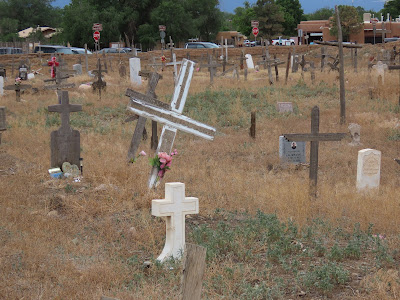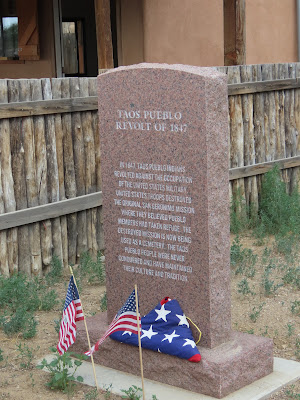Taos, New Mexico (elevation 6,969 feet) was the next stop on our Southwest journey. Alesia did her research and really wanted us to visit the Taos Pueblo UNESCO World Heritage Site- and I’m glad we did because this is a fascinating slice of American history. And it represents a people today holding on to traditions and a way of life.
Upon arrival, I didn’t know what to expect. I guess I was thinking ancient dwellings in the side of mountains, a la the Aztecs and Incas. Not really the case at all.
The adobe dwellings are old but they are also very much in use today as homes for today’s Tiwa or Tiwa Puebloans (or Taos Indians which is easier to remember). Other structures are shops where art, crafts, jewelry, and other items made by these native Americans are sold to tourists.
Adobe is an ancient building material. It is dried mud brick made from sun-dried clay, straw, sand, and water. The structures are regularly resurfaced and repaired when needed. The Taos Pueblo website says the dwellings are “mudded” annually by the homeowners or a designated group of men. The homes are generally passed down from generation to generation with the eldest son being the owner. “The homes are our connection to our way of life and to our ancestors,” the website says.
Adobe style homes and businesses are prevalent in Taos, Santa Fe and Albuquerque.
Taos Pueblo is one of North America’s oldest continuously inhabited communities going all the way back to the 1200s.
Around 150 Tiwa people live in the village. There are some 2,000 tribal members in the area. They have their own Tiwa language.
We heard how for centuries the dwellings had no entry doors. Out of fear of rival Indian attacks, the Pueblos used ladders to enter openings in the roofs. The ladders were kept inside, making it hard for bad guys to attack at night.
Today there are front doors but the residences have no electricity or running water. Residents choose to live as their ancestors lived. They use outhouses and a community shower facility nearby.
It may sound like a dog’s life but these are proud and independent people. They also have concerns that adding plumbing and air conditioning wiring and units could damage their Adobe homes.
For food the residents farm crops of corn, pumpkin squash, and red beans that are part of the nearly 100,000 acres the Taos Native Americans own in the area. For meat, they hunt Elk and own 160 Bison kept on a nearby ranch. Four Bison were to be slaughtered the next day, we were told.
The pueblo (Spanish for town) is bisected by Red Willow Creek which is the source of water for drinking and cooking. Our guide told us, as a resident, she safely drinks the creek water but if we did so we would likely become sick.
Cottonwood trees flank the guide.
There are regularly scheduled tours of the village. They are free but visitors are encouraged to tip the guide, which of course we did. This young lady, a Taos Indian herself, was very knowledgeable and articulate. She patiently answered all of the group’s questions, making for a comprehensive experience, I felt.
She said the people living in the adobe structures strictly follow the rules of the “ceremonial” life, an interesting choice of words.
Our tour began outside San Geronimo or St. Jerome Chapel built in 1850. St. Jerome is Taos Pueblo’s patron saint.
The Spanish first built a church near this site in 1619. It was destroyed in a revolt by Native Americans against Spanish rule in 1680, rebuilt then again destroyed in 1847 by the U.S. Army during the Mexican War.
Visitors are asked not to photograph the inside. Instead, I bought this postcard that shows the sanctuary with its colorful array of Catholic figures including Jesus and the Virgin Mary. St. Jerome is represented too.
The Taos Indians are 90 percent Catholic.
This is the location of the original St. Jerome church built in 1619 by the Spanish who forced the Tiwa inhabitants to become Christians. As previously stated it was twice destroyed first in 1680 when the Tiwa revolted against their Spanish oppressors. It was rebuilt 10 years later. In 1847 the Americans bombarded the church in retaliation for the assassination of the U.S. territorial governor as the Tiwa people and their Hispano allies resisted American rule. The U.S. Army shelled the chapel where hundreds of Tiwa had gathered and were killed.
The church bell tower was restored and serves as a reminder of lives lost in the attack, according to the Taos Pueblo website.
The church ruins are surrounded by a graveyard. The burial ground is off-limits to visitors but photos can be taken from the fence around it.
The majority of grave markers are simple wooden crosses, reminding me of cemetery scenes in old Western movies.
The burial grounds is on the popular site Find A Grave as San Geronimo Cemetery, Taos, N.M. There are 208 entries of people interred there, most without images, which are common to include.
I found this grave interesting with its wide base topped by a cross. It belongs to Marie Lujan. Carved in the wood is her name, 1-24-30 to 10-24-94 (when she was born, when she died) and this nice epitaph: “In God’s Haven She Finds Peace.”
Several items placed on her grave show that Marie was loved and is missed.
Another Lujan, Joseph C., has a military headstone. He was a veteran of the Spanish-American War in 1898. Lujan was a corporal in Company G of the 1st Territorial Volunteer Infantry. The unit was made up of volunteers from New Mexico, Arizona and Oklahoma, which were not yet states, and Indian Territory.
After our 30-minute tour ended we checked out this memorial site on the Taos Pueblo grounds. The tall plaques list the names of tribe members who served in the military during America's wars.
One headstone is inscribed with the names of Taos Pueblo men who died or survived the notorious Bataan death march on the Philippines early in World War II. Sixty-four soldiers from Taos were in the 200th Coast Artillery. They fought valiantly against the Japanese invasion. But the Japanese force was too strong and in April 1942 75,000 American and Philipino troops surrendered. The prisoners were forced on a brutal 65-mile walk that became known as the Bataan Death March.
Some 1,500 U.S. prisoners including a number of Taos Pueblo men died amid the Japanese mistreatment as did 25,000 Filipino captives.
The previously mentioned Taos Pueblo Revolt of 1847 against the U.S. Army occupation is also memorialized. This was during the Mexican War when U.S. artillery destroyed the San Geronimo Church killing scores of residents sheltering inside. The strike was in retaliation for the killing of the American territorial governor.
The inscription on the stone ends with “The Taos Pueblo People We’re Never Conquered And Have Maintained Their Culture And Tradition.”
I’m really glad we visited Taos Pueblo! I learned so much about these proud people and their lasting influence on the Southwest region of America.
Admission fees are $25 for adults and $22 for seniors, military and students. Children 10 and under get in free.




























No comments:
Post a Comment